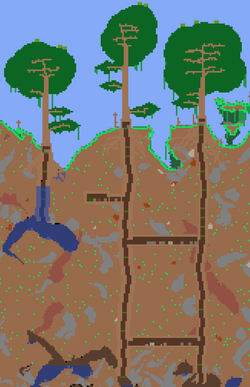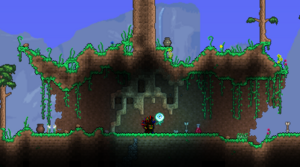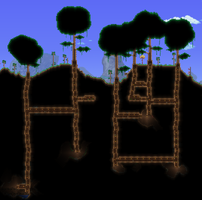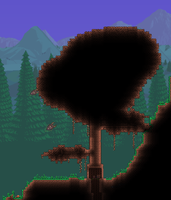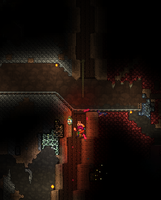Living Tree
Living Trees are large tree-shaped structures generated at world creation. Unlike regular trees, Living Trees are constructed from solid foreground Living Wood and Leaf Blocks, rather than being background objects that characters can pass through.
Living Trees are very large and often (but not always) contain an internal, vertical tunnel structure which leads down to a "treasure room", which contains Living Tree-themed furniture and a Living Wood Chest, all of which can be looted. The chest can contain either a Living Wood Wand (for placing Living Wood), a Leaf Wand (for placing Leaf Blocks), or a Living Loom (for crafting Living Wood furniture).
On the ![]() Desktop version,
Desktop version, ![]() Console version, and
Console version, and ![]() Mobile version, Living Trees have larger and rounder tops and can generate in groups (see Generation section for details). They also have horizontal tunnels that can connect to other trees or lead outside of them. Chests can be generated inside these tunnels. The treasure room will be located underneath one of the trees, and contain a Living Loom instead of a Living Wood Table. The entrance to their internal tunnels are enclosed, requiring a pickaxe to enter them. Gnomes can also be found more often within Living Trees.
Mobile version, Living Trees have larger and rounder tops and can generate in groups (see Generation section for details). They also have horizontal tunnels that can connect to other trees or lead outside of them. Chests can be generated inside these tunnels. The treasure room will be located underneath one of the trees, and contain a Living Loom instead of a Living Wood Table. The entrance to their internal tunnels are enclosed, requiring a pickaxe to enter them. Gnomes can also be found more often within Living Trees.
(Desktop, Console and Mobile versions) Smaller, Living Mahogany Trees are found deep in the Underground Jungle. They are always hollow with an Ivy Chest at their base, containing Jungle Shrine items.
Contents
 Gnome(Desktop, Console and Mobile versions)
Gnome(Desktop, Console and Mobile versions)
 Living Wood Chest
Living Wood Chest Living Loom(Desktop, Console, Old-gen console and Mobile versions)
Living Loom(Desktop, Console, Old-gen console and Mobile versions) Living Wood Door
Living Wood Door Living Wood Table
Living Wood Table Living Wood Chair
Living Wood Chair Living Wood Wall
Living Wood Wall Living Wood Platform(Desktop, Console, Old-gen console and Mobile versions)
Living Wood Platform(Desktop, Console, Old-gen console and Mobile versions)
 Leaf Wand
Leaf Wand Living Wood Wand
Living Wood Wand Sunflower Minecart(Desktop, Console and Mobile versions)
Sunflower Minecart(Desktop, Console and Mobile versions) Ladybug Minecart(Desktop, Console and Mobile versions)
Ladybug Minecart(Desktop, Console and Mobile versions) Finch Staff(Desktop, Console and Mobile versions)
Finch Staff(Desktop, Console and Mobile versions) Magic Mirror(Only on (3DS version))
Magic Mirror(Only on (3DS version)) Enchanted Boomerang(Only on (3DS version))
Enchanted Boomerang(Only on (3DS version)) Band of Regeneration(Only on (3DS version))
Band of Regeneration(Only on (3DS version)) Bug Net(Only on (3DS version))
Bug Net(Only on (3DS version)) Band of Starpower(Only on (3DS version))
Band of Starpower(Only on (3DS version))
Notes
- When mined with a pickaxe or drill, Living Wood turns into plain Wood and Leaf Blocks are destroyed.
- In small worlds, some Living Trees extend high enough for Harpies to spawn.
- On the
 Desktop version,
Desktop version,  Console version, and
Console version, and  Mobile version, the naturally generated Living Wood Walls are considered unsafe walls, thus cannot be directly used for NPC houses. On the
Mobile version, the naturally generated Living Wood Walls are considered unsafe walls, thus cannot be directly used for NPC houses. On the  Old-gen console version and Nintendo
Old-gen console version and Nintendo version, naturally generated Living Wood Walls are considered safe walls.
- Up to five Living Trees can spawn in a single world on the
 Old-gen console version and Nintendo
Old-gen console version and Nintendo version.[1]
- In drunk worlds(Desktop, Console and Mobile versions), the regular Dungeon entrance is replaced by a Living Tree, with its vertical tunnel leading to a underground room where the Old Man spawns. The tiles of the Living Tree are painted with Brown Paint.
Generation
Information taken from the ![]() Desktop 1.4.4.9 source code, method
Desktop 1.4.4.9 source code, method GenerateWorld() in Terraria.WorldGen.cs. The related generation pass is Living Trees.
- The maximum groups of Living Trees for all world sizes:
| World size | Max. group |
|---|---|
| Small | 2 |
| Medium | 3 |
| Large | 4 |
- In drunk worlds, Celebrationmk10 worlds, and Don't dig up worlds, more groups of Living Trees can be generated.
- Each group of Living Trees has a "main" tree, with possible "secondary" Living Trees generated beside it. Main trees will have the treasure room, while secondary trees only generate horizontal tunnels.
- In a regular world, 3 secondary Living Trees can be generated on each side at most, so the maximum total number of Living Trees in a group is 7.
- In drunk worlds, Celebrationmk10 worlds, and Don't dig up worlds, more secondary Living Trees can be generated.
When generating the world, the game will first determine the amount of generation attempts of Living Tree groups, this number is related with world size and secret world seeds. The game will first set the default amount; if the default amount is 0, there is a 1/2 (50%) chance for it to be increased by 1. Then the game checks for activated secret world seeds, and increases the attempt amount based on world size.
| World size | Attempts | |||
|---|---|---|---|---|
| Default | Secret world seeds activated[a] | |||
| Drunk world | Celebrationmk10 | Don't dig up | ||
| Small | 0–2 | +2 | +3 | +2 |
| Medium | 0–3 | +3 | +4 | +3 |
| Large | 0–4 | +4 | +6 | +4 |
- ↑ Get fixed boi worlds are considered as activating the drunk world seed.
- Examples of generation attempt amounts:
- A small world can have 0–2 attempts.
- A large Celebrationmk10 world can have 6–10 attempts.
- A large Get fixed boi world can have 4–8 attempts.
Then, the game will choose the coordinates of Living Tree generation. The horizontal coordinate is randomly chosen within the following range:
- Regular worlds: between the two Oceans.
- Celebrationmk10 worlds: central 70% of the world.
- If this horizontal coordinate is less than 200 tiles from the center of the world, the attempt is consumed without generating Living Trees.
Then, determine the coordinate of generation. This check starts at the top true world border and ends at the surface layer.
- After reaching the first Dirt Block within this range, the tile above the Dirt Block is selected as the coordinate of generation.
- If this chosen tile meets any of the conditions below, the attempt is consumed without generating Living Trees:
- The tile is less than 150 tiles away from the top true world border.
- The tile is less than 50 tiles away from Mountain Caves.
- There are any of the following tiles within a 100×100 rectangular area centered on the tile[i 1].
- If this chosen tile meets any of the conditions below, the attempt is consumed without generating Living Trees:
Afterwards, the game will generate a Living Tree (the "main" Living Tree of a group) at this coordinate, and attempt to generate some "secondary" Living Trees beside it. The number of attempts on each side can be altered by activated secret world seeds.
| Default | Secret world seeds activated[a] | ||
|---|---|---|---|
| Drunk world | Celebrationmk10 | Don't dig up | |
| 0–3 | + (2–4) | + (2–4) | + (1–5) |
- ↑ Get fixed boi worlds are considered as activating the drunk world seed.
- Examples of "secondary" Living Tree generation attempt amounts:
- 0–3 attempts on each side by default, resulting in 7 Living Trees in a group at most (1 + 3 + 3).
- A Don't dig up world can have 0–8 attempts on each side, resulting in 17 Living Trees in a group at most (1 + 8 + 8).
- A Get fixed boi world can have 0–7 attempts on each side, resulting in 15 Living Trees in a group at most (1 + 7 + 7).
- Note that the amounts of attempts on each side are not necessarily equal. For example, it's possible for 2 attempts to be performed on the left side and 1 attempt to be performed on the right side.
Secondary trees to the left of the main tree are generated first, then trees to the right of the main tree. On each side, secondary trees are generated from near to far. Similar to the main Living Tree, the generation of secondary Living Trees also use coordinates.
- The initial horizontal coordinate of the first secondary tree to be generated on each side start at the horizontal coordinate of the main tree.
- Then, for each secondary tree on the side, perform the following actions:
- Get the horizontal coordinate of the tree by substracting/adding (determined by which side of the main tree the generation is performing at) a random value between 13–30 to the current horizontal coordinate.
- If this horizontal coordinate is less than 200 tiles from the center of the world, the attempt is consumed without generating Living Trees.
- Set the vertical coordinate to the vertical coordinate of the main tree. If the new coordinate is a solid tile, move upwards until an unoccupied tile is found; if the new coordinate is unoccupied, move downwards until a solid tile is found, then set the coordinate to the tile above the solid tile. This is the final tile the secondary Living Tree is generated at.
- Similar to the main Living Tree, if there are any of the following tiles within a 100×100 rectangular area centered on the tile[i 1], the attempt is consumed without generating Living Trees:
- Get the horizontal coordinate of the tree by substracting/adding (determined by which side of the main tree the generation is performing at) a random value between 13–30 to the current horizontal coordinate.
- Footnotes
Tips
- (Old-gen console and 3DS versions) The treasure rooms in Living Trees can be used for NPC housing by simply adding a light source.
- During Hardmode, Living Trees act as natural barriers against the evil biomes' and Hallow's increased rate of spreading, provided that the area beneath the tree is cleared.
- Because the tunnel inside the tree is curving slightly and it contains several platforms, the player does not need to fear taking fall damage from jumping down.
- Living Trees can provide some help when fighting the Destroyer. Standing on top of a Living Tree forces the boss to make more predictable attacks.
Trivia
- Sometimes Living Trees' internal tunnels can be replaced entirely by an Enchanted Sword Shrine, causing the Living Tree to be only at surface level. There may be small traces of Living Tree wood underneath the ground, to determine if this occurred.
Gallery
A pre-1.4.0.1 Living Tree which spawned without an underground portion.
(Desktop, Console and Mobile versions) A single Living Tree with a treasure room, viewed with Terrafirma.
The Living Tree painted with Brown Paint that acts as the entrance to the Dungeon in a drunk world.
A Living Tree blocking the spread of The Crimson underground.
History
- Desktop 1.4.4: Odds of containing a minecart increased from 1/10 to 1/6. If it does contain one, it is still a 50/50 chance to be a Sunflower or Ladybug Minecart.
- Desktop 1.4.0.1:
- Can now generate in groups of 1-7.
- These groups have horizontal tunnels that can interconnect each other.
- Gnomes now ocassionally spawn in Living Trees.
- Living Trees' interior entrances are blocked off with Living wood.
- Living Wood Chests now have a 1/3 (33.33%) chance of containing the Finch Staff and a 1/10 (10%) chance of containing the Ladybug or Sunflower Minecart.
- The tops of Living Trees are rounder.
- The walls of the rooms in Living Trees are no longer considered valid for NPC housing.
- Treasure room now contain a placed Living Loom rather than a Living Wood Table.
- Can now generate in groups of 1-7.
- Desktop 1.3.0.1:
- Living Mahogany Trees introduced.
- Living Trees now spawn with Living Wood Platforms instead of Wood Platforms.
- Desktop 1.2: Introduced.
- Console 1.02: Introduced.
- Switch 1.0.711.6: Introduced.
- Mobile 1.4.0.5.0: Added all features and changes from Desktop 1.4.0.1.
- Mobile 1.2.6508: Introduced.
- 3DS-Release: Introduced.


